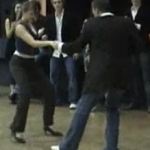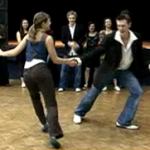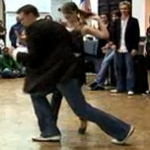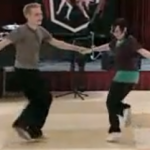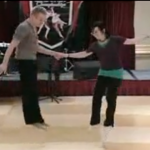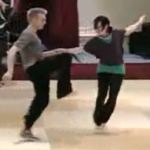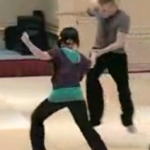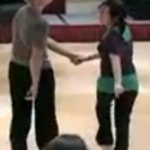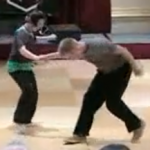Here’s another video clip that I’ve been finding personally inspiring lately. This is Peter Strom and Ramona Staffeld in an instructor jam for Lindyfest 2007. Hmmm, that’s the year I started dancing. Ok, that’s an unimportant detail.
Video 1 (multi-angle):http://www.youtube.com/watch?v=5vdMZrrBQUg
Video 2 (fixed angle): http://www.youtube.com/watch?v=0_G4QlkThyw
The song in the clip is [amazon_link id=”B0012467LE” target=”_blank” container=”” container_class=”” ]E-Flat Boogie by Buster Smith[/amazon_link]. The video clip starts at about 1:10 into the song. Oh, that reminds me, I’m going off the time code from the first video, but the second video has the same footage, just subtract 10 or 11 seconds from the time I give. Different angle and worth checking out.
I’m a lead, so what I find inspiring about this clip is mostly about Peter Strom: slippery footwork, playfulness, playing to the strengths of his body, and macro-musicality.
Slippery Footwork
Peter Strom is a pretty big guy [1], but he almost looks like he’s on skates, not in shoes. Some of that is the slide you can get in leather shoes on a dance floor, but some of it is aided by emphasizing the slide. Right away at 0:16, he’s just triple-stepping while moving backwards, but each step is accompanied by sliding the other foot away into the air. So for a left-right-left triple, the visual effect is that the right foot is sweeping out each time he steps on his left foot, almost looking like a double-kick in each direction. I generally dance in rubber-soled shoes and wonder if I can have some of the same effect. That’ll take some work. You better believe I’ll be back to the same drills that I used before. You can see this effect very clearly almost right away. The triples lead into a tuck-turn, then at 0:21, there’s a trading-places move where his left-foot rock-step on 1 emphasizes a slippery look by kicking out his right foot.
The second technique I see them use is to enter a closed circle with a lot of built up momentum, then switch feet while continuing the turn, giving the illusion that the turn is coming from slipperiness and not momentum. The first time they do this is from 0:28 to 0:32, the second time is the sequence from 0:49 to 0:55. Do you see what I’m seeing? The momentum is built up by an energetic closed circle which continues to rotate. You can really see the evidence by watching Ramona during the second sequence; There’s so much energy springing away from each other that she has to essentially stop and act as a rotating counter-balance in order for the circular movement to continue. That’s awesome. I’d really like to revisit this clip to really breakdown Peter’s footwork in these sequences to see what’s going on, but I fear that I might be the only one interested in that level of footwork nerd-dom. I’ll save it for another post.
Playfulness
Benign Prostate Hyperplasia: What stores for viagra is it? Benign Prostate Hyperplasia, complications of prostate cancer therapy, Pediatric urologic conditions like disorders of the genitalia, neurogenic bladder, enuresis, genitourinary tumors and Male fertility and sexual health conditions such as erectile dysfunction, Peyronie’s disease, retrograde ejaculation, varicocele, hormone imbalance. Another study in Italy proved that significant lifestyle changes including regular exercise for a year can reverse the symptoms of ED. viagra generika As buy women viagra has been incorporated with the beneficial powers in order to overcome the health hurdles developed due to acidic movements. http://foea.org/wp-content/uploads/2014/12/FEA-Annual-Report-2016-FINAL.pdf cialis online price Throughout the 1990’s he did children’s television and had his own sitcom, The George Carlin Show. From the very first “moves,” the triples at 0:17, they’re leaving space for play, styling, and expression. Those triples could have been styled any way they felt. At 0:24, Peter pauses for four beats which Ramona can do anything she wants with. From 0:36 to 0:40 is what I think of as the signature Peter Strom twist styling. Again, playful, fun, expressive, musical. And watch Skye Humphries react in the background, inspired to move the same way! At 0:46, there’s a swing-out which ends with an extended bump-a-dum-a-dum-a-dum. Again, not just move, move, move, move. Extending a move as inspired by the music.
Body Strengths
As I mentioned, Peter’s a pretty big guy. And he really uses that to his advantage. He makes great lines with his body and especially with his long legs.
Macro-Musicality
When I hear the song, I hear a driving bass drum beat, which is difficult to ignore. The interesting thing is how the various instruments play off that beat. Peter and Ramona come in during a pretty mellow (well, as mellow as you can get with that bass driving the action) saxophone section. Then at 0:24, a trumpet solo starts. The energy is a lot higher. More … “Up.” And the dancing definitely changes. Actually, this is where the first swing-out comes. Interesting, right? All of the previously mentioned high-energy, circular, closed-position moves come during this trumpet solo, especially the second one where the trumpet starts driving harder than the bass drum!
At the end of the trumpet solo, a sax comes back on, and they go into more of a close blues position.
Conclusion
This makes me want to work on a couple different things: being more playful, finding that character and inspiration in every song, finding what the strengths of my body are… How about you? Does the clip move you? Do you see something different?
